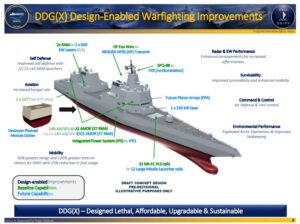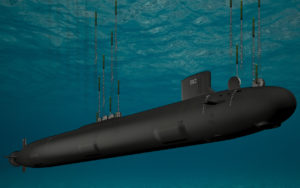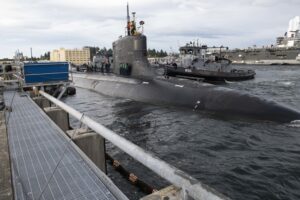The Congressional Budget Office’s (CBO) annual analysis of the Navy’s fiscal year shipbuilding plan said the DDG(X) next-generation guided-missile destroyer could cost up to $3.4 billion each and the SSN(X) next-generation attack submarine could cost up to $7.2 billion each.
The report underscored the Navy’s FY 2023 long-range shipbuilding plan said production of the DDG(X) is expected to start in 2030, two years later than the December 2020 shipbuilding plan and five years later than the fiscal year 2020 plan. The 2022 plan includes three Alternatives, two under continued restrained funding and one with significant additional funding.

Under the options the Navy laid out, the service would buy 38 DDG(X)s in Alternative 1, 29 under Alternative 2, or 47 under Alternative 3. The Navy is considering buying two ships per year starting in 2033 and largely keep that rate through 2052, but in Alternative 2 purchases would start slower with one ship power year through 2040 and then alternate with one and two ships per year until 2052.
CBO said while the Navy estimated the average cost of the DDG(X) would vary from $2.3 billion per year under Alternatives 1 and 3 to $2.4 billion per year under Alternative 2, due to varying purchase rates, the report is skeptical of those numbers.
It said the Navy indicated the initial design for DDG(X) required a ship displacing 13,500 tons for a larger hull than the DDG-51 Flight III with combat capabilities equivalent or superior to it. DDG(X) would be 2,000 tons more than the DDG-51 Flight III
“If that is the case, then the Navy’s estimates imply that the DDG(X) would cost 10 percent more than the DDG-51 Flight III but would have a full-load displacement that is 40 percent greater,” the report said.
CBO warned this outcome is “unlikely on the basis of the history of building new surface combatants.”
The report noted that previously the Navy estimated the Zumwalt-class (DDG-1000) destroyers would cost only slightly more than DDG-51s, despite being 50 percent larger.
“Ultimately, costs for the DDG-1000 increased by about 45 percent,” CBO said.
CBO said the Navy argued DDG(X) is different because it will have a very similar combat system and radar to the DDG-51 Flight III destroyer and only need a new hull and power system. DDG-1000 included new technology that affected all major aspects of ship design.
Ultimately, CBO estimates the average cost of DDG(X) will cost from $3.1 billion to $3.4 billion under the Navy’s three shipbuilding plan estimates, ranging from 34 to 42 percent more than the Navy estimates.
CBO estimated the Navy would require either $125 billion under Alternative 1, $99 billion for Alternative 2, or $146 billion for Alternative 3.
“Overall, the program represents roughly 30 percent to 40 percent of the difference between the Navy’s and CBO’s estimates of the total cost of the Alternatives in the 2023 shipbuilding plan. The uncertainty about the ultimate size and capabilities of the next-generation destroyer suggests that its final cost could differ substantially from both the Navy’s and CBO’s estimates,” the report continued.
This is in line with the CBO analysis that the Navy is underestimating the overall cost of its shipbuilding plan Alternatives.
The Navy estimates the cost of buying new ships in Alternative 1 is $689 billion, Alternative 2 is $696 billion, and Alternative 3 is $763 billion.
In contrast, CBO estimated buying only the new ships in the FY ‘23 plan would cost $795 billion in Alternative 1, $834 billion in Alternative 2, or $881 billion in Alternative three. This equates to between $26.5 to $29.4 billion per years in 2022 dollars.
CBO highlighted the Navy’s 30-year shipbuilding plan only reports the cost of new battle force ship construction and does not include nuclear refueling, outfitting new ships, or purchasing other vessels like sealift ships that are still funded via the Navy’s shipbuilding account.
“If those costs were included, the Navy’s average annual shipbuilding costs in the 2023 plan would increase by about $3 billion, CBO estimates. That increase would add to both the Navy’s estimate and CBO’s estimate of the cost of new-ship construction.”

CBO also said its shipbuilding cost estimates are generally higher than the Navy’s because of different assumptions about the design and capabilities of future ships, different estimating methods, and they analyze growth in the costs of labor and materials for shipbuilding differently.
“Some of the difference in the estimates stems from uncertainty about the design and capabilities of large ships whose construction would begin in 5 or 10 years—in particular, the next-generation destroyer that would start to replace the Navy’s Arleigh Burke class destroyers and the next-generation attack submarine to follow the service’s Virginia-class submarines.”
The report said the estimate differences also increase over time because of different methods for developing constant-dollar estimates, with the Navy not accounting for historically faster growth in the costs of labor and materials in the shipbuilding compared to the economy overall.
The SSN(X) differences are also considerable due to some of these factors. CBO underscored the biggest different between the three Alternative shipbuilding plans is procurement of attack submarines.
Under Alternatives 1 and 3, the Navy would keep buying Virginia-class attack boats with the Virginia Payload Module (VPM) until 2036 and start building the new SSN(X) in 2034 and enter serial production in 2037, with Alternative 3 including slightly more of each type of submarine.
Alternative 1 has the Navy buy 23 Virginia-class boats with the VPM and 31 SSN(X)s and Alternative 3 includes 27 Virginia-class submarines with VPM and 33 SSN(X)s. The Navy would buy both types are a rate of about two per year over 30 years.
However, under Alternative 2 the Navy would keep buying Virginia-class submarines with the VPMs, return to buying a version without the VPM in 2030, and start buying the SSN(X) in 2034, “keeping all of those types of submarines in production through 2052.”
This translates into 33 Virginia-class submarines with VPM, 16 without VPM, and 17 SSN(X)s. The Navy would mostly buy them at a rate of two per year, but sometimes three per year.
CBO warned that “critically, under Alternative 2, all three classes of attack submarines would remain in production through 2052. That could pose substantial challenges for the submarine industrial base, which would be finishing production of the Columbia class at about the same time (in the 2030s) that production of large payload submarines would begin.”
Overall, the Navy and CBO agree the cost of Virginia-class ships with VPM in Alternative 1 and 3 are on average about $3.3 billion per ship. The more complex Alternative 2 diverges more significantly.
In Alternative 2 the Navy estimates VPM-equipped submarines will cost $3.3 billion and Virginia-class without VPM will cost $.28 billion each.
The report estimated higher costs “because Virginia-class ships would continue in production through 2052 under that Alternative, and the real growth in their production costs would thus compound over a longer period, CBO estimates that both types of ships would cost $3.7 billion each, on average.”

CBO said while the VPM-equipped Virginia-class submarines are much larger than the version without it, moving to build both means “the effects of rate, learning, and real cost growth would cause the average price of both types of submarines to be the same over the 30-year period.”
“Ships with VPMs are nonetheless fundamentally more expensive than those without them. A Virginia-class submarine with a VPM would cost $4.4 billion in 2051, for example, but without a VPM would cost $4.0 billion that year, CBO estimates,” the report continued.
CBO said it is difficult to estimate the cost of SSN(X) because the Navy has not determined its size or capabilities but has indicated it wants the vessel to be faster, stealthier, able to carry more torpedoes, and a vertical launch capability.
This implies taking features from the Seawolf-class, the Los Angeles-class, and Virginia-class submarines.
“CBO’s cost estimates therefore reflect the assumption that the SSN(X) would be similar to a Seawolf-class submarine but would have an entirely new design. The submarine’s advanced features would make it as quiet and stealthy as possible; it could launch missiles from missile cells and would contain a torpedo room the size of those on Seawolf-class submarines.”
Therefore, CBO estimated SSN(X) will be 10,100 tons of displacement when submerged, 11 percent larger than the Seawolf-class. It came to this conclusion by comparing the Los Angeles-class to the Virginia-class, which incurred an 11 percent increase in displacement with new technology and vertical missile capability.
CBO also said it looked at the Ohio-class vs. Columbia-class ballistic missile submarines. New technology increased displacement by about 21 percent, but the report used the smaller estimate because they are attack submarines.
Given these factors, while the Navy estimates each SSN(X) will cost $5.6 billion for any Alternatives, CBO estimated each submarine will cost $6.2 billion to $7.2 billion each, depending on which Alternative is used.
CBO said this is a reflection of the varying construction schedules for SSN(X) in the three alternative plans.
Under Alternatives 1 and 3, the SSN(X) would be built in similar quantities and mostly at a rate of two per year from 2037 to 2052. Under Alternative 2, however, only half that number of SSN(X)s would be built, resulting in less savings from the learning effect and less cost reduction for the program over the 30-year period.”